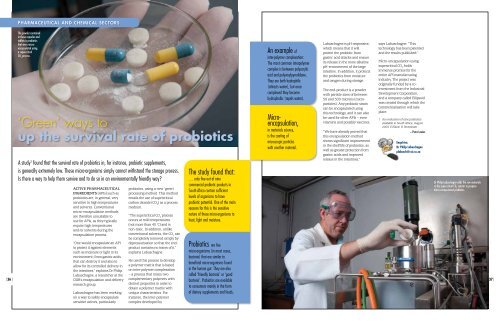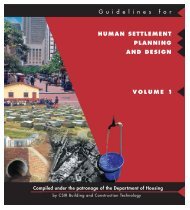PHARMACEUTICAL AND CHEMICAL SECTORS| 36 |The powder containedin these capsules <strong>and</strong>tablets is probioticsthat were microencapsulatedusinga supercriticalCO 2process.‘Green’ ways toup the survival rate of probioticsA study 1 found that the survival rate of probiotics in, <strong>for</strong> instance, probiotic supplements,is generally extremely low. These micro-organisms simply cannot withst<strong>and</strong> the storage process.Is there a way to help them survive <strong>and</strong> to do so in an environmentally friendly way?Active pharmaceuticalingredients (APIs) such asprobiotics are, in general, verysensitive to high temperatures<strong>and</strong> solvents. Conventionalmicro-encapsulation methodsare there<strong>for</strong>e unsuitable touse <strong>for</strong> APIs, as they typicallyrequire high temperatures<strong>and</strong>/or solvents during theencapsulation process.“One would encapsulate an APIto protect it against elementssuch as moisture or light in itsenvironment; from gastric acidsthat can destroy it <strong>and</strong> also toallow <strong>for</strong> its controlled delivery inthe intestines,” explains Dr PhilipLabuschagne, a researcher at the<strong>CSIR</strong>’s encapsulation <strong>and</strong> deliveryresearch group.Labuschagne has been workingon a way to safely encapsulatesensitive actives, particularlyprobiotics, using a new ‘green’processing method. This methodentails the use of supercriticalcarbon dioxide (CO 2) as a processmedium.“The supercritical CO 2processoccurs at mild temperatures(not more than 40 ˚C) <strong>and</strong> isnon-toxic. In addition, unlikeconventional solvents, the CO 2canbe completely removed simply bydepressurisation so that the endproductcontains no traces of it,”explains Labuschagne.He used this process to developa polymer matrix that is basedon inter-polymer complexation– a process that mixes twocomplementary polymers withdistinct properties in order toobtain a polymer matrix withunique characteristics. Forinstance, the inter-polymercomplex developed byThe study found that:… only five out of ninecommercial probiotic products inSouth Africa contain sufficientlevels of organisms to haveprobiotic potential. One of the mainreasons <strong>for</strong> this is the sensitivenature of these micro-organisms toheat, light <strong>and</strong> moisture.Probiotics are livemicro-organisms (in most cases,bacteria) that are similar tobeneficial micro-organisms foundin the human gut. They are alsocalled ‘friendly bacteria’ or ‘goodbacteria’. Probiotics are availableto consumers mainly in the <strong>for</strong>mof dietary supplements <strong>and</strong> foods.An example ofinter-polymer complexation:The most common interpolymercomplex is between polyacrylicacid <strong>and</strong> polyvinylpyrrolidone.They are both hydrophilic(attracts water), but oncecomplexed they becomehydrophobic (repels water).Microencapsulation,in materials science,is the coating ofmicroscopic particleswith another material.Labuschagne is pH responsive,which means that it willprotect the probiotic fromgastric acid attacks <strong>and</strong> ensureits release in the more alkalinepH-environment of the largeintestine. In addition, it protectsthe probiotics from moisture<strong>and</strong> oxygen during storage.The end-product is a powderwith particle sizes of between50 <strong>and</strong> 500 microns (microparticles).Any probiotic straincan be encapsulated usingthis technology, <strong>and</strong> it can alsobe used <strong>for</strong> other APIs – evenvitamins <strong>and</strong> possibly vaccines.“We have already proved thatthis encapsulation methodshows significant improvementin the shelf life of probiotics, aswell as greater protection fromgastric acids <strong>and</strong> improvedrelease in the intestines,”says Labuschagne. “Thistechnology has been patented<strong>and</strong> the results published.”Micro-encapsulation usingsupercritical CO 2holdsimmense promise <strong>for</strong> theentire API manufacturing<strong>industry</strong>. The project wasoriginally funded by a coinvestmentfrom the IndustrialDevelopment Corporation,<strong>and</strong> a company called Ellipsoidwas created through which thecommercialisation will takeplace.1 An evaluation of nine probioticsavailable in South Africa, August2003, E Elliott, K Teversham– Petro LowiesEnquiries:Dr Philip Labuschagneplabusch@csir.co.zaDr Philip Labuschagne adds the raw materialsto the supercritical CO 2reactor to preparemicro-encapsulated probiotics.| 37 |
PHARMACEUTICAL AND CHEMICAL SECTORS| 38 |Dr Stoyan StoychevThe <strong>CSIR</strong> is currently buildingcapacity <strong>for</strong> large-scalerecombinant production ofbiopharmaceuticals. At present,there are a number of suchproducts at various stages in the<strong>development</strong> pipeline, includingtherapeutic peptides such asExenatide (diabetes treatment),Enfurvitide <strong>and</strong> Griffithsin (HIVinhibitors) as well as anti-rabiesmonoclonal antibodies (mAbs).Production of biologicsBiopharmaceuticals areconventionally produced insterile fermentation facilitiesusing mammalian cellcultures. A drawback of suchsystems is that they have aUsing biologics totrans<strong>for</strong>m the drugmarketplaceBiologic products now provide important therapeutic options <strong>for</strong> a range of serious clinical conditions.Therapeutic biologics such as genetically engineered recombinant proteins <strong>and</strong> monoclonal antibodies representa large portion of newly-approved therapies <strong>for</strong> conditions such as chronic inflammatory diseases <strong>and</strong> cancer.limited production capacity,<strong>and</strong> setting up such facilitiesrequires a huge capitalinvestment. Biologics mayalso be produced by usingrecombinant micro-organismsor plants engineered to expressa particular therapeutic peptide,protein, monoclonal antibodyas well as vaccine sub-unit.The pharmaceutical <strong>industry</strong>is now being trans<strong>for</strong>med dueto the emergence of biologics(biopharmaceuticals) whichoffer many advantages overconventional small-moleculedrugs. These include higherefficacy, reduced side effects,<strong>and</strong> the potential to curedisease, compared to treatingsymptoms.The size <strong>and</strong> complexity ofbiologics, in comparison tosmall-molecule drugs, havebrought a unique set ofchallenges to manufacturers.Therapeutic peptides,proteins <strong>and</strong> mAbs have tobe scrutinised at primary aswell as higher-order (native)con<strong>for</strong>mation. Close attentionmust also be paid to anymodifications induced bythe recombinant expressionsystem. In addition, product<strong>and</strong> process-related substances<strong>and</strong> impurities can affect boththe structure <strong>and</strong> functioningof biologics. Hence, it is criticalto be able to detect dimidiated,isomerised, oxidised <strong>for</strong>ms,or protein aggregates as wellas host cell protein, DNA <strong>and</strong>culture components introducedduring cloning, production <strong>and</strong>purification.In-depth characterisationof biologicsUnder these circumstances,manufacturers have to ensurethat their products undergorigorous characterisation tofacilitate transition throughdiscovery into <strong>development</strong>,eventual commercialisation,<strong>and</strong> their ultimate intendedtherapeutic use. Achievingthis goal is dependent on theavailability of appropriateanalytical tools to provide anarray of chemical <strong>and</strong> physicalin<strong>for</strong>mation. Hence, a rangeof approaches has beendeveloped, optimised <strong>and</strong>successfully implementedin-house <strong>for</strong> in-depthcharacterisation of biologics witha focus on meeting regulatory<strong>and</strong> commercial specifications inorder to shorten time-to-marketas well as lower risk duringproduct <strong>development</strong> stages.The identity of recombinantlyexpressed peptides, proteins<strong>and</strong> mAbs is scrutinisedusing a combination ofproteolytic digestion followedby multi-dimensional liquidchromatography peptidefractionation, directly coupledto t<strong>and</strong>em mass spectrometry.This workflow yields highresolutionpeptide sequencingdata that not only permit indepthcharacterisation of primarystructure, but also allow directdetection of post-translationalmodifications product as wellas process-related impurities.In addition, in-house developedmicrospheres (ReSyn TM ) arebeing used to manufactureimmobilised protease microreactors<strong>for</strong> fast <strong>and</strong> efficientprotein digestion that yieldshigh coverage primarystructure data.Cutting-edge ultrahigh-pressureliquidchromatography systemsProduct purity is monitoredusing electrophoresisas as wellas chromatography-basedtechniques, with separationbased on a range of molecularproperties such as size, charge,as well as hydrophobicity. Theuse of cutting-edge, ultra-highpressureliquid chromatographysystems in combination withcolumns packed with smaller,sub 2 μm size particles, allows<strong>for</strong> more efficient as well as faster separation of moleculesof interest.Since native structure dictatesfunction, the underst<strong>and</strong>ing ofstructure <strong>and</strong> its interplay withfunction is essential <strong>for</strong> developingeffective, safe, <strong>and</strong> cost-effectiveprotein biopharmaceuticals.The native con<strong>for</strong>mation of largerpeptides, proteins <strong>and</strong> mAbsis examined on a global scaleusing circular dichroism, whichmonitors changes in secondarystructure, <strong>and</strong> fluorescencespectroscopy to monitor thetertiary <strong>and</strong> quaternary structurallevels of complex biologics. Futureef<strong>for</strong>ts will also centre on the<strong>development</strong> <strong>and</strong> implementationof cutting-edge techniques<strong>for</strong> in-depth characterisationof native con<strong>for</strong>mation on alocal scale. This will furthersupplement existing capabilitiesby allowing site-specific<strong>and</strong> detailed con<strong>for</strong>mationalcharacterisation, that would beuseful throughout all stages ofprotein drug <strong>development</strong>, fromoptimisation of target binding <strong>and</strong>receptor interaction(s) in research,to <strong>for</strong>mulation, stability <strong>and</strong>comparability studies in process<strong>development</strong>, where in<strong>for</strong>mationon changes in con<strong>for</strong>mation couldplay an important role in the<strong>development</strong> <strong>and</strong> optimisationof complex biologics.In order to demonstrate thatmethods are appropriate <strong>for</strong> usein drug <strong>development</strong>programmes, substantial time<strong>and</strong> resources are required. Inthe year ahead, our focus willbe on method qualification <strong>and</strong>validation so that the assayscurrently being used are deemedcompliant with internationalexpectations, <strong>and</strong> mostimportantly, that the analyticaldata derived from these methodsretain their full scientific value.– Dr Stoyan StoychevEnquiries:Dr Stoyan Stoychevsstoychev@csir.co.zaWhat are biologics?A biologic is a prophylactic, an in vivo diagnostic or atherapeutic substance that:• Is produced only by a living system, but is not simply ametabolite;• Is stated to contain a single substance that has documentedbiological activity or activities;• Has a relatively large molecular weight with a high structuralcomplexity compared with biologically active substancesthat can be made by chemical synthesis; is inherentlyheterogeneous in the molecular species present, <strong>and</strong> has animpurity profile that depends critically upon the processesused to make <strong>and</strong> test each batch; <strong>and</strong>• Has activity that is often very sensitive to physical conditions(i.e. temperature, shear <strong>for</strong>ces, phase) <strong>and</strong> enzymatic action.| 39 |
















